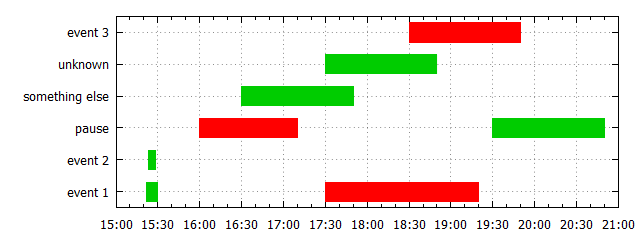Updated: Now includes handling the data sample and uses mpl dates functionality.
import matplotlib.pyplot as plt
from matplotlib.dates import DateFormatter, MinuteLocator, SecondLocator
import numpy as np
from StringIO import StringIO
import datetime as dt
### The example data
a=StringIO("""a 10:15:22 10:15:30 OK
b 10:15:23 10:15:28 OK
c 10:16:00 10:17:10 FAILED
b 10:16:30 10:16:50 OK
""")
#Converts str into a datetime object.
conv = lambda s: dt.datetime.strptime(s, '%H:%M:%S')
#Use numpy to read the data in.
data = np.genfromtxt(a, converters={1: conv, 2: conv},
names=['caption', 'start', 'stop', 'state'], dtype=None)
cap, start, stop = data['caption'], data['start'], data['stop']
#Check the status, because we paint all lines with the same color
#together
is_ok = (data['state'] == 'OK')
not_ok = np.logical_not(is_ok)
#Get unique captions and there indices and the inverse mapping
captions, unique_idx, caption_inv = np.unique(cap, 1, 1)
#Build y values from the number of unique captions.
y = (caption_inv + 1) / float(len(captions) + 1)
#Plot function
def timelines(y, xstart, xstop, color='b'):
"""Plot timelines at y from xstart to xstop with given color."""
plt.hlines(y, xstart, xstop, color, lw=4)
plt.vlines(xstart, y+0.03, y-0.03, color, lw=2)
plt.vlines(xstop, y+0.03, y-0.03, color, lw=2)
#Plot ok tl black
timelines(y[is_ok], start[is_ok], stop[is_ok], 'k')
#Plot fail tl red
timelines(y[not_ok], start[not_ok], stop[not_ok], 'r')
#Setup the plot
ax = plt.gca()
ax.xaxis_date()
myFmt = DateFormatter('%H:%M:%S')
ax.xaxis.set_major_formatter(myFmt)
ax.xaxis.set_major_locator(SecondLocator(interval=20)) # used to be SecondLocator(0, interval=20)
#To adjust the xlimits a timedelta is needed.
delta = (stop.max() - start.min())/10
plt.yticks(y[unique_idx], captions)
plt.ylim(0,1)
plt.xlim(start.min()-delta, stop.max()+delta)
plt.xlabel('Time')
plt.show()
![Resulting image]()



